Television has always been an important vehicle for political campaigning. The rise of television delivered through the internet has given campaigners new possibilities for political advertising and micro-targeting, customisable down to the individual viewer.
What is it?
Our television viewing habits have acquired valuable political currency due to changes in the delivery of TV content and the role of personal data in the process. Together, these two developments make internet-enabled television — commonly referred to as 'Advanced TV' — possible.
What you watch and what you read online have created many different opportunities for intelligence gathering and influence among political campaigns and special-interest groups who are keen on learning more about you. Data on your viewing and reading habits reveals a wealth of information about your preferences, interests, lifestyle and beliefs, all of which political entities can leverage in their campaigns.
The use of Advanced TV (sometimes marketed as Smart TV technology) in political intelligence gathering, and the deployment of that data via 'Advanced TV Targeting', or 'Addressable TV', is particularly interesting because the practice is not well-known and since most viewers are unaware of its existence.
Changes in TV Consumption & Advertising
As technology has evolved, our habits of media consumption have, too. The advertising industry today defines two types of television:
Linear TV (broadcast television or pushed content): follows a set schedule and includes preset commercial breaks. Linear TV content includes national cable network programmes and local TV networks. Someone who turns on her TV, explores the limited number of channels available, and tunes in to something that happens to be broadcast at that moment is consuming content in a linear fashion.
Advanced TV: Increasingly, TV is consumed via non-linear modes in which content is consumed more flexibly (on-demand or pulled content). Viewers choose what they want to watch, when and through what delivery mechanism. There is a wide range of mechanisms through which users can access OTT ('over-the-top') content, sidestepping traditional media controllers and distributers. All these services work by transporting content over the internet from a provider to a connected device outside of cable networks, telecoms and other closed networks. Examples include:
• Content consumed on mobile phones, tablets, and computers (e.g. Hulu, Netflix, Amazon Video, YouTube TV, mobile apps like WatchESPN)
• Smart and Connected TVs
• Set-top boxes (e.g. Roku, Apple TV)
• Gaming consoles (e.g. PlayStation, Xbox One)
The business models for these services range from subscription-based to pay-as-you-go.
Advanced TV enables campaigners to target advertisements with the same precision as those delivered over the internet, displayed on mobile phones and sent via snail mail. Advertising via Advanced TV – what the industry calls 'Addressable TV' – is the next generation of television advertising. Addressable TV allows ads to be targeted to specific households instead of indiscriminate demographics across whole cities or states, as with traditional TV advertising.
How relevant is it and where is it being used?
The freedom offered by non-linear modes of consumption has led to wide adoption of over-the-top devices around the world. The Interactive Advertising Bureau (IAB) reported that 56% of American consumers' TVs are IP-connected and that non-linear consumption is on the rise. In recent years, American business leaders have discussed expansion opportunities for Addressable TV outside of the US.
Liberty Global, a company that claims to be the largest international cable company, has started rolling out set-top boxes to its markets globally, including in Austria, Belgium, the Czech Republic, Chile, Germany, Hungary, the Netherlands, Poland, Romania, Slovakia, Puerto Rico and the UK.1
Related internet-enabled TV services have also been introduced in Bosnia and Herzegovina, Bulgaria, Canada, China, Colombia, Croatia, Denmark, the Dominican Republic, El Salvador, Estonia, Finland, Georgia, Greece, Guatemala, Honduras, Iceland, India, Kazakhstan, Latvia, Lithuania, Macedonia, Malaysia, Moldova, Mongolia, Montenegro, Nicaragua, Norway, Pakistan, the Philippines, Serbia, Slovenia, Sri Lanka, Sweden, Turkey and Uzbekistan.
Experts forecast that internet-enabled TV will expand most rapidly in the Asia Pacific region, the Middle East and Latin America, where the bulk of subscriber growth will likely take place. The global market is growing at an unprecedented rate and is expected to reach nearly $80 billion by 2020 and about $117 billion by 2025 due to skyrocketing demand.
The advertising opportunities have, in turn, burgeoned dramatically. Advertising "spend in OTT is expected to hit $40 billion by 2020" according to the IAB. Data from all of these set-top boxes can generate new data sets and enrich existing data from other sources, which may in turn catch the interest of political campaigns outside of the US. Companies have an incentive to whet campaigns' interest in addressable advertising. As Warren Schlichting, senior VP of Media Sales at Dish Network commented, "Political spending is a rapidly growing market, and this allows us to go after new money."
How does it work and how is your data used?
The data that can be collected from Advanced TV viewership has created new opportunities for advertisers, whose work is fuelled by data. As Brian Gleason, CEO of the global digital media company Xasis, stated, "Voter data is the lifeblood of political advertising...By bringing this data into the digital space, we’re opening up an entirely new level of sophistication for political marketers...”
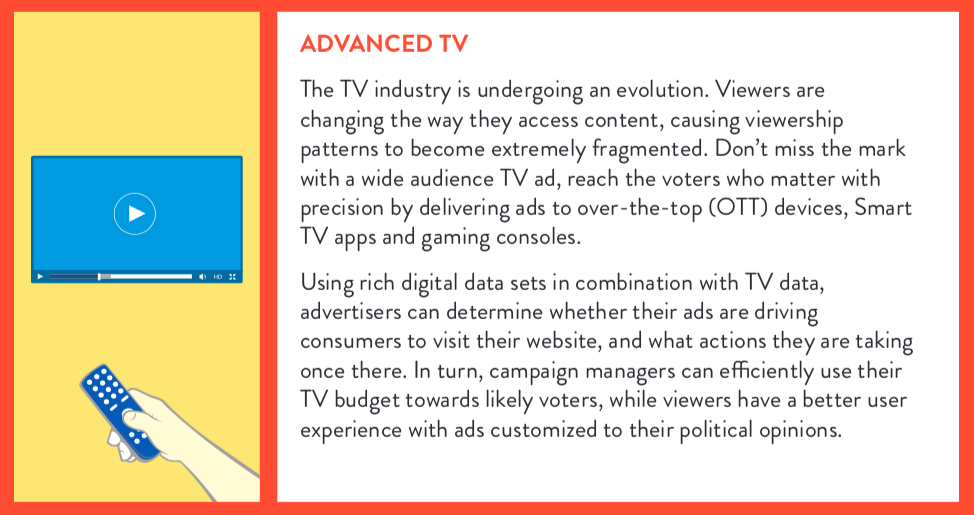
The next generation of TV advertisements are called "addressable" because advertisers now more than ever have both the information and the technology available to address the needs and wants of individual users. Addressable TV ad targeting can occur in different modes (linear/live, playback, or on-demand), through set top boxes, cable, or IPTV (short for internet protocol TV, the delivery of TV content over the internet).
People are calling for the end of big data, but set top box viewing data combined with voter data gives accurate and real insights into what targeted voters are watching. - Tim Kay, NCC Media's Director of Political Strategy
Advanced TV achieves individual household-level precision by collecting and analysing data on its users. The data involved comes from three sources:
- First-party data: In-house data that the advertiser has collected on you. This may include, for instance, which commercials you've watched and which you've fast-forwarded through or whether you're more amenable to image or text-heavy advertisements.
- Second-party data: Second-party data encompasses information from partnerships and affiliates in which data is shared (see Case Study: D2 Media Sales).
- Third-party data: Data purchased from a separate source (e.g., Acxiom, Experian, LiveRamp, Neustar or others that specialise in political data). This information ranges widely, but in political contexts usually includes how persuadable you are and how likely you are to show up at the ballot box.
All of this personal, demographic, geographic and behavioural data is aggregated and analysed in determining whether you are a good candidate for an advertisement and in evaluating how you respond to it.

As Experian advertises in its white paper on Addressable TV, "Addressable TV is about the person and not the program. You and your next door neighbour may be watching the same show, but through the power of Addressable TV, end up viewing different ads." The paper's tagline is: "Harness the power of audience data for one-to-one targeting."
Cablevision's CEO Ben Tatta shed light on political campaigns' use of Addressable TV in this clip recorded in April 2016.
Case Study: D2 Media Sales
In 2014, Dish Network, an American satellite TV company, and DIRECTV, an AT&T subsidiary, partnered to form D2 Media Sales, which was then the "largest household addressable TV advertising platform" in the US. D2 Media's advertising platform delivers addressable ads to nearly 22 million households. The company forged partnerships with data providers across both major American political parties including i360, which services Republican campaigns, and TargetSmart, which caters to centre-left candidates. In 2016, D2 Media provided addressable TV ads to over 100 political campaigns.
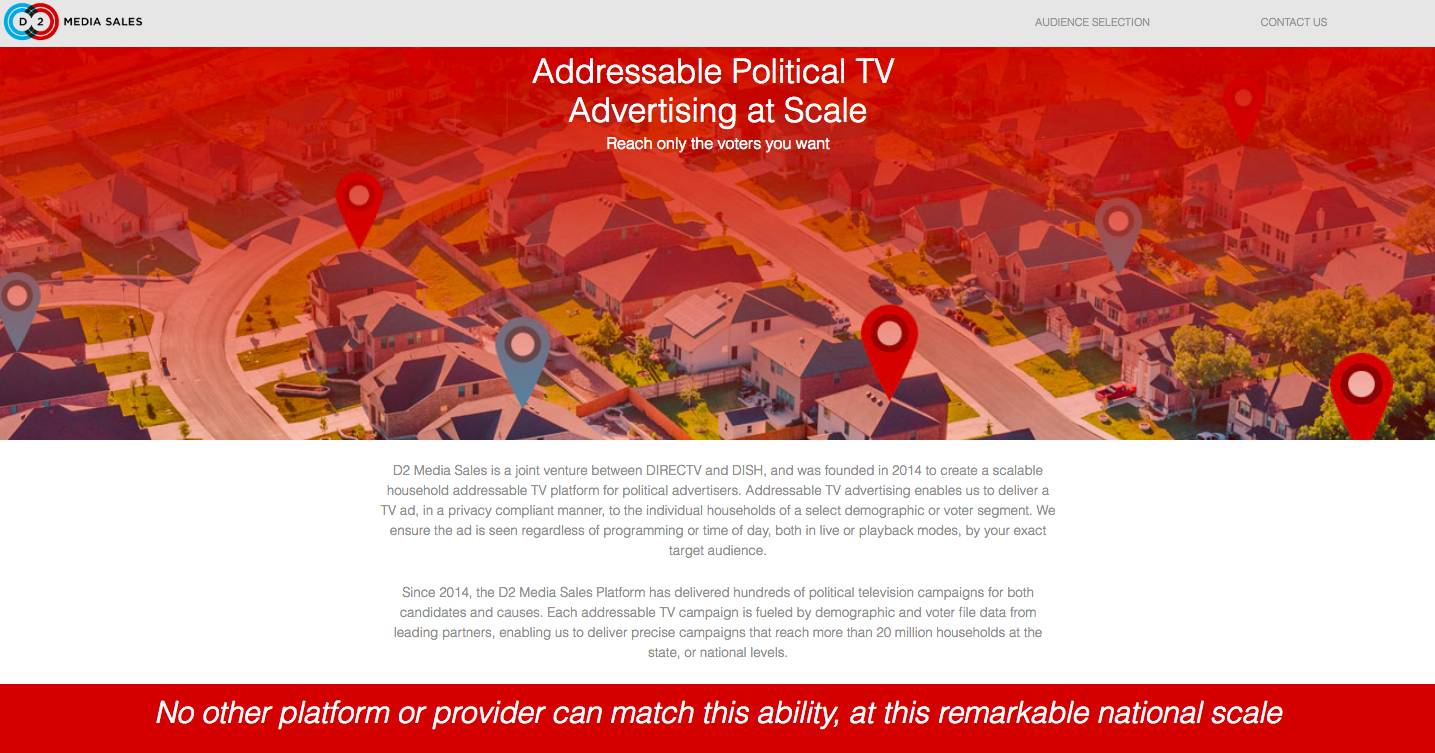
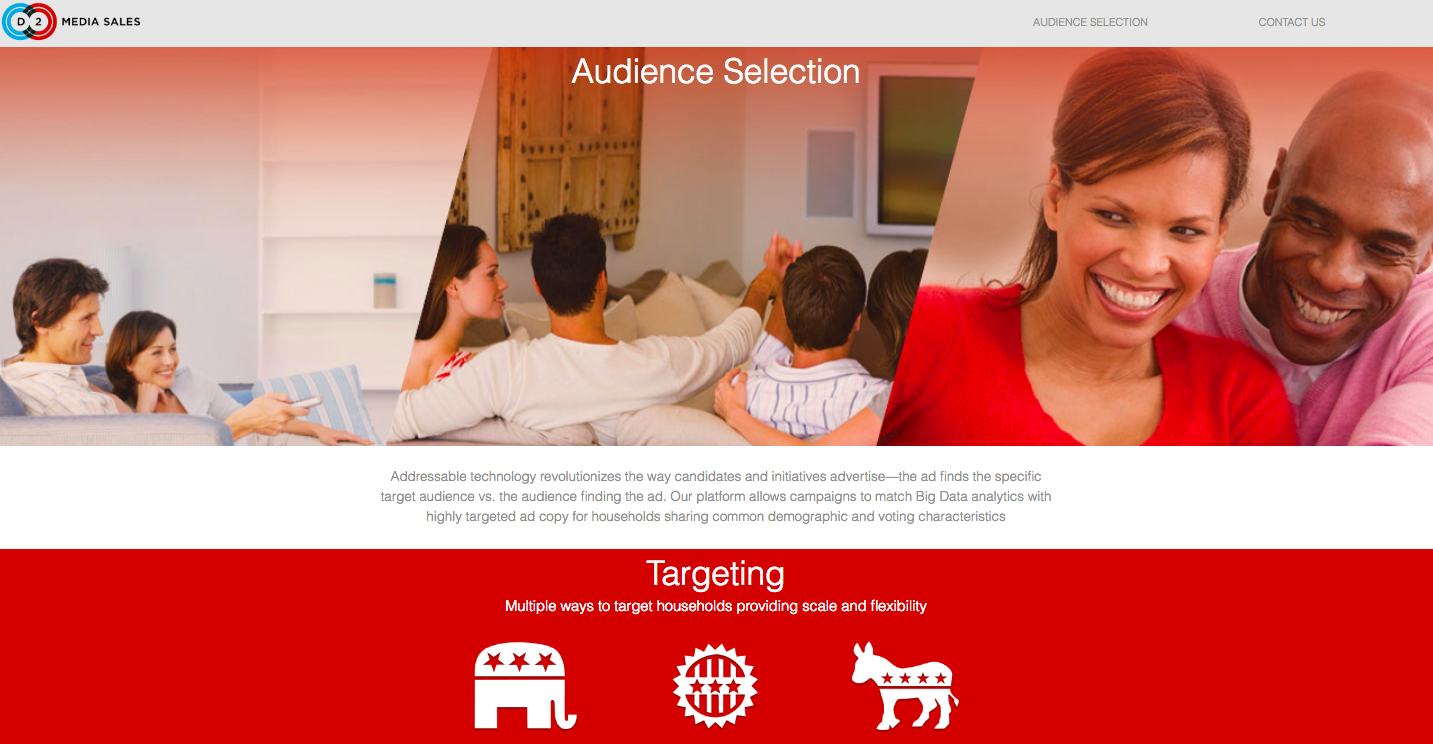
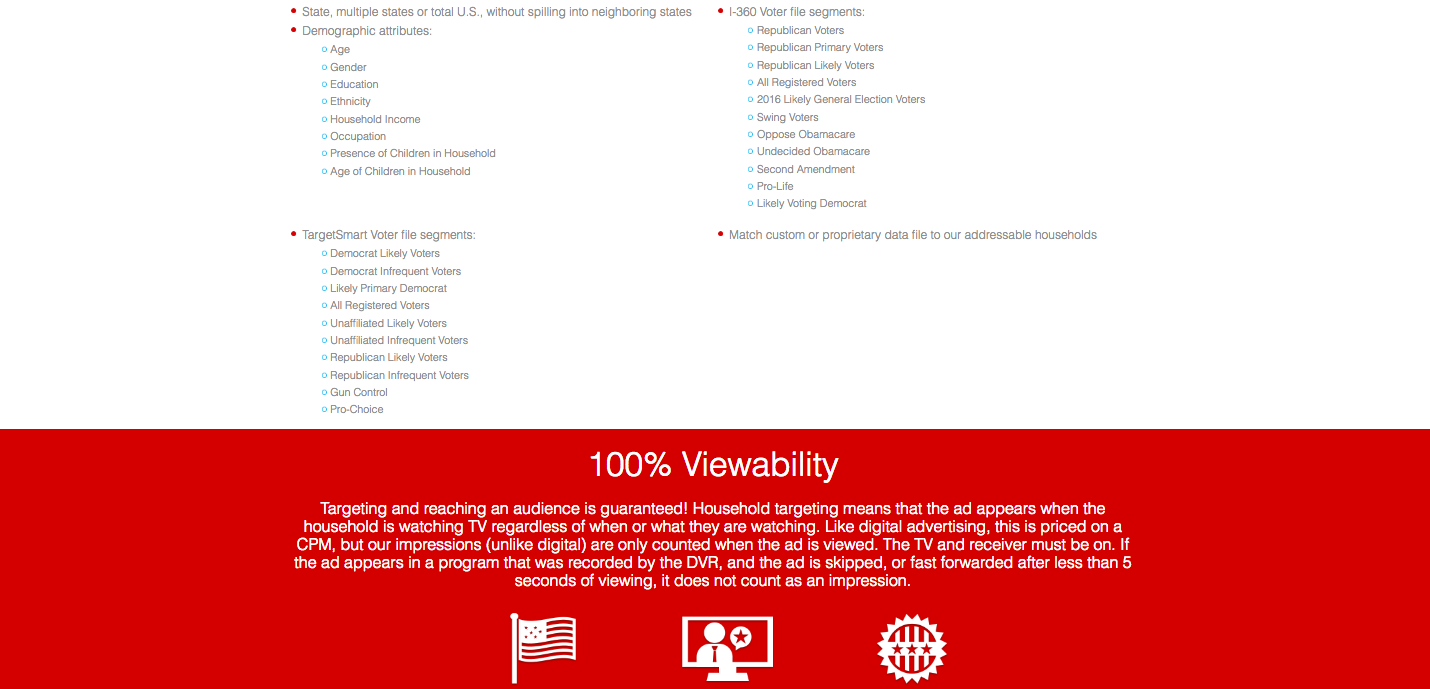

D2 Media Sales also maintains a partnership with Deep Root Analytics, an American media analytics company that caters to Republican campaigns.
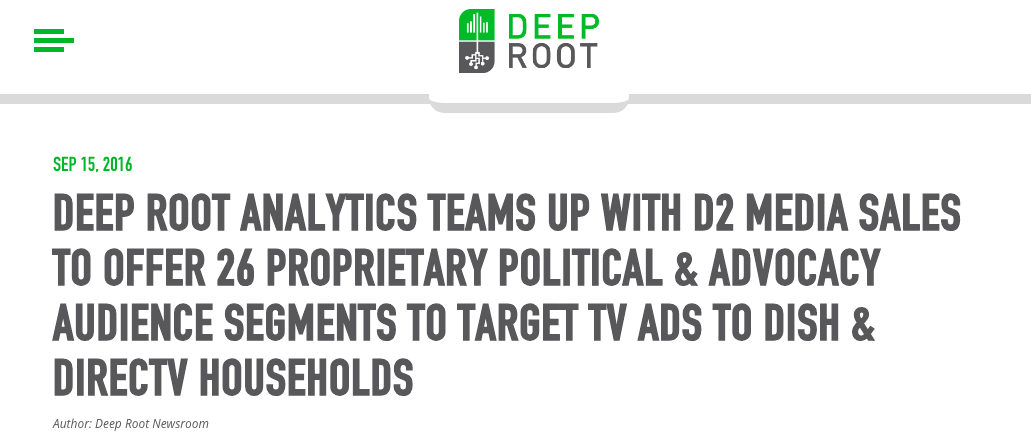
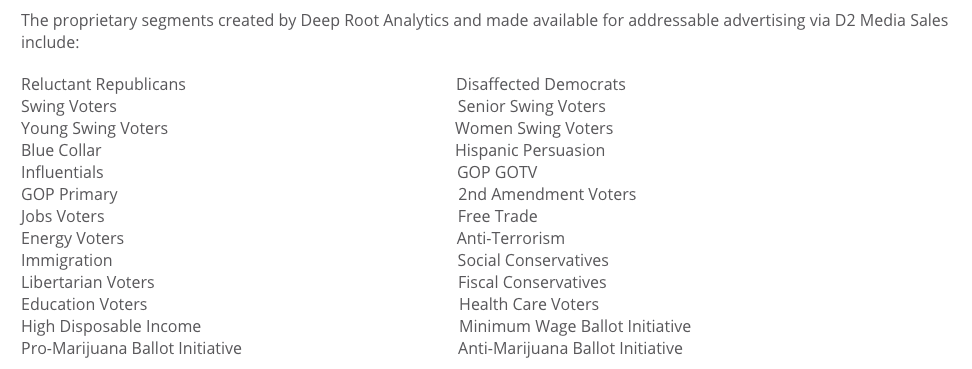
The images above, taken from a Deep Root Analytics press release, show the 26 audience segments Deep Root Analytics has provided to D2 Media. The data presumably encompasses D2 Media's 22 million households. ('GOTV' in the second column is a common abbreviation for 'Get Out The Vote.')
Case Study: Altice Media Solutions
Altice Media Solutions, a digital advertising company whose clients range from Fortune 500 companies to local businesses, also offers Addressable TV advertising services to political campaigns.
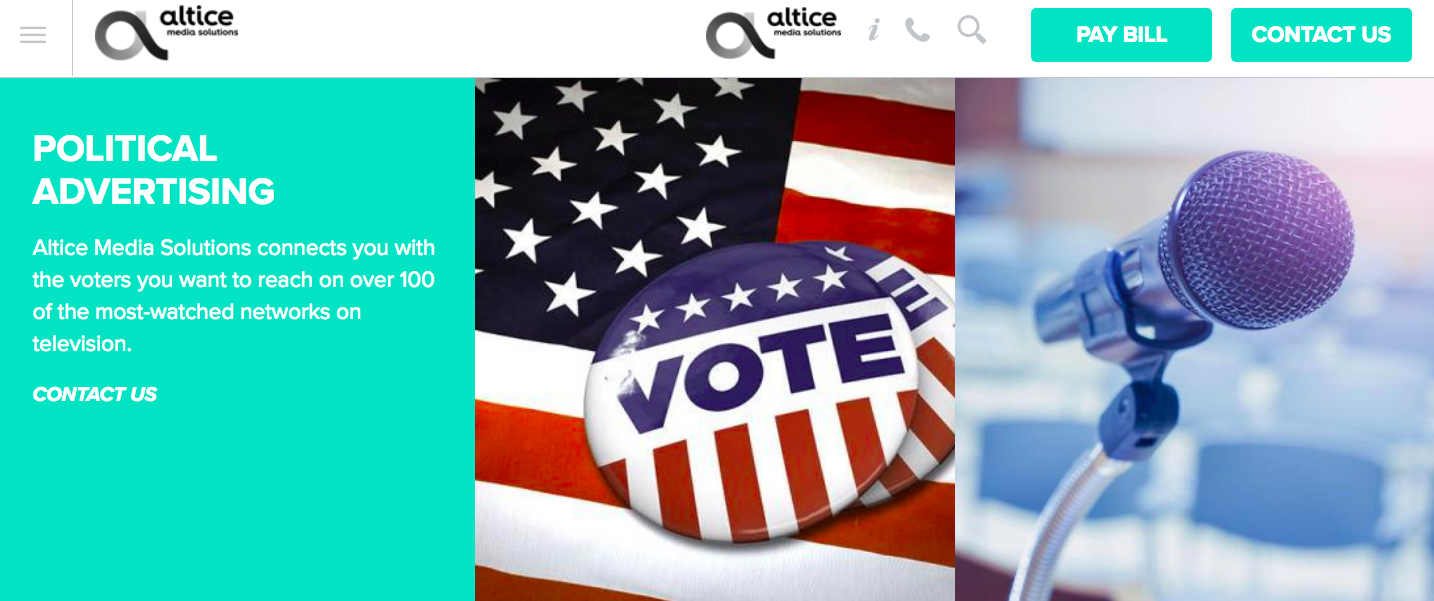
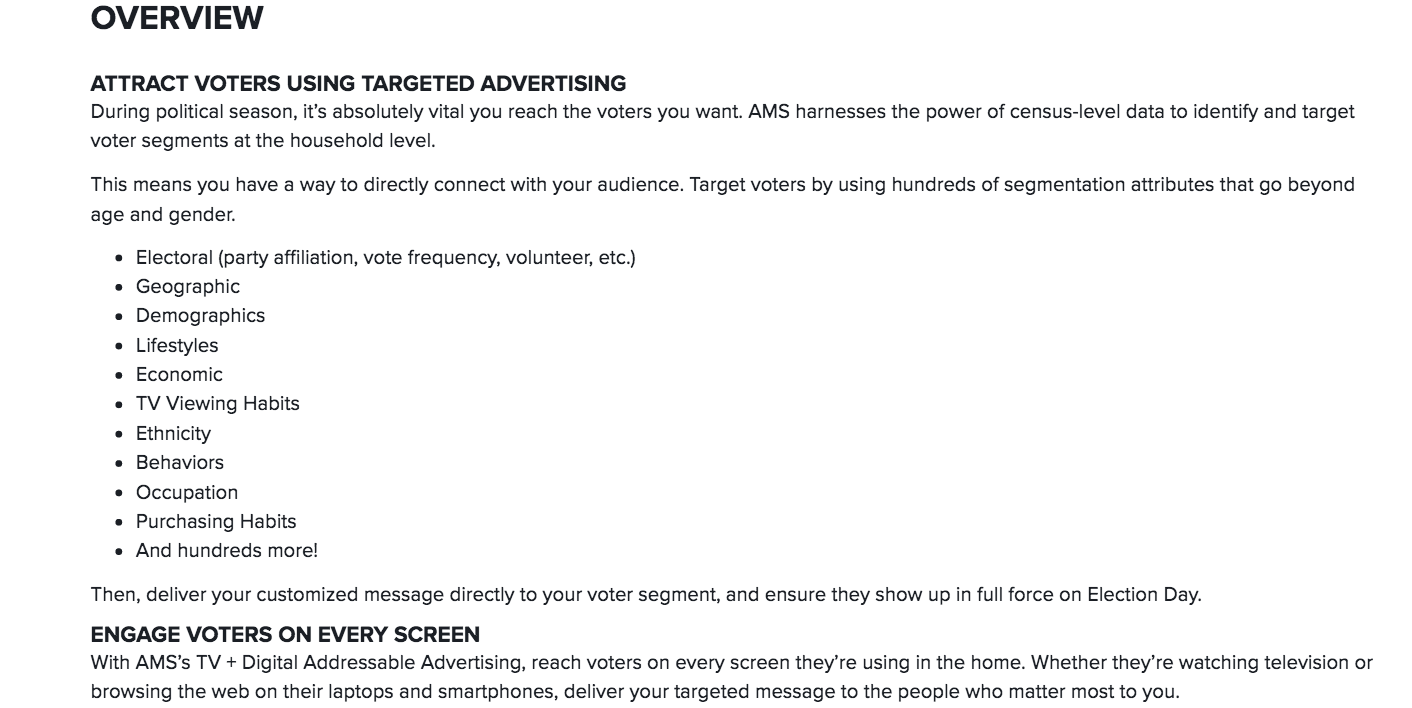
Altice Media Solutions offers the ability to target voters via addressable TV using not only basic demographics but also ethnicity and purchasing habits, among others. Its parent company offers media services in the US, Western Europe, Israel and overseas territories. Source, Source
Is it new?
Though the term "Advanced TV Targeting" was first introduced in 1990 at the MIT Media Lab, it wasn't until recently that the practice gained momentum. Three factors came together to facilitate the adoption of Addressable TV advertising: the 2016 American election cycle and the search for a competitive advantage; the technological infrastructure and advancement of advertising agency capabilities; and – perhaps a longer-term trend – the "consolidation of the media industry." As the amount of content sent over IP, OTT and on-demand platforms reached a critical mass, Addressable TV became a viable option for political strategists. In fact, according to D2 Media Sales, the "2016 presidential election cycle [was] the first [presidential] one in which campaigns have been able to target voters with addressable television advertising." Between the 2014 and 2016 American election cycles, the use of addressable TV increased about 60%.
Why should we care?
While companies offering Addressable TV services claim that it can strengthen the democratic process by improving the efficiency of political campaigns and by fostering political participation, it also introduces risks. In fact, both Germany and the Netherlands have recognized the sensitivity of personal information processed by Advanced TV and have introduced the right to watch anonyously among other enforcement actions. While local regulations differ, the generally wide gap between media practices and data protections presents a host of concerns.
Proponents of Addressable TV advertising tout the ability to display different ads to neighbours living on the same street. While this technology may be advantageous for selling some goods and services, the costs of this personalisation in political campaigning are different. Household-level targeting of political ads can easily lead to the erosion of the public sphere, as individual voters may understand candidates and their campaigns differently based on the information they've been fed. In addition, "During most of a campaign, you want to target persuadable voters," as HaystaqDNA CEO Ken Strasma stated. As a result, some voters who are believed to be unpersuadable may be neglected entirely if political campaigns deem them an unproductive use of campaign resources.
Furthermore, the advertisements served to individual households reflect the campaign's understanding of individuals living in those homes, knowledge that can be acquired through invasive or privacy-compromising means. When voters are included in an advertising campaign, addressable advertising is symbolic of "a shift from identifying groups to identifying people," as president and CEO of digital media agency Bully Pulpit Interactive remarked. Moreover, advertisers' data on individual households — whether directly observed or predicted — may be inaccurate or outdated, leading to political profiles and advertising campaigns unfit (at best) or outright damaging (at worst) for voters.
Additionally, most TV watchers do not consider the fact that their viewing habits and preferences can be – and are – used to shape how political campaigns communicate with and persuade them. Perhaps that would make a good TV show itself, but what would watching it reveal about you?
Varoon Bashyakarla is a data scientist and researcher at the Tactical Technology Collective. His past statistical undertakings led him to a variety of domains: public health, public safety, sports, finance, and cybersecurity. After working as a data scientist in Silicon Valley, he is now living in Berlin and exploring how personal information is used for political influence.
1 Liberty Global's Q4 statements reflected a nearly 200% increase in revenue from Latin America and the Caribbean, which drove its stock price up over 15% in a single day. The company gained nearly 100,000 new customers in Latin America and the Caribbean in 2016 alone.↩
Thank you to Christy Lange, Stephanie Hankey, Amber Macintyre, and Daisy Kidd for their discerning comments. A big thank you to Gary Wright for his technical assistance posting this piece online.
Published June 18, 2018.
Gwajin A/B: Gwaje-gwaje wajen tura sakonnin yakin neman zabe
التلفزيون الموجه: من يشاهد ما تشاهده؟
Akwatin Talabijin mai jin magana: Wa ke kallon abinda kake kallo?
Keta hurumi, Fallasa, da Kutse: Yadda rayuwar bayanan mai zabe ke cikin hadari
Manhajojin jirgin yakin neman zabe: Danna ka yi musharaka
អេបយុទ្ធនាការឃោសនា៖ ចុចដើម្បីចូលរួម
بيانات المستهلكين: وقود الحملات الرقمية
Bayanan mutane: Makamashin wutar yakin neman zabe a kafafen zamani
Dados Pessoais: Persuasão Política. Dentro da Indústria da Influência. Como funciona.
Datos Personales: Persuasión Política. Cómo funciona la Industria de la Influencia desde Adentro.
Sauraron bayanai a kafafen zamani: Daga dandalin sada zumunta
الاستهداف الجغرافي: القيمة السياسية لأماكن وجودك
Isa ga mutum ta inda yake: Amfanin wuraren da kake zuwa don manufar siyasa
البيانات الشخصية: عملية الإقناع السياسي
Bayanan mutane: Amfani da su wajen janyo ra’ayin siyasar mutane
Личные данные: политические убеждения. Внутри индустрии влияния
Особисті дані: політичне переконання. Всередині галузі впливу
التصنيف النفسي: الإقناع حسب الشخصية
Amfani da ayyukan mutum wajen kiyasin dabi’arsa: Janyo hankalin mutum ta dabi’arsa
Kiran wayan da tura sakonnin mutum-mutumi: Yakin neman zaben ta na’urar yi da kanka
تأثير نتائج البحث: الوصول إلى الناخبين الباحثين عن إجابات
Tasiri wajen amsoshi yayinda kake bincike: Isa ga masu kada kuri’a a zabe masu tambayoyi
Bibiya daga wani na-gefe: Kukis, Bikons, zanen yatsu da sauransu
Fasahohi masu tasowa: Abubuwan da zasu jagoranci fasahar yakin neman zabe
Kundin masu zabe: Bayanan siyasa a game da kai
ទិន្នន័យផ្ទាល់ខ្លួន៖ ការបញ្ចុះបញ្ចូលផ្នែកនយោបាយ ឥទ្ធិពល និងដំណើរការនៅក្នុងឧស្សាហកម្មនេះ មានជាភាសាខ្មែរ
Now Translated - Personal Data: Political Persuasion. Inside the Influence Industry
Tools of the Influence Industry
ទិន្នន័យអ្នកប្រើប្រាស់៖ ការបង្កើតឲ្យមានយុទ្ធនាការឃោសនាតាមបែបឌីជីថល
Dados de Consumidor: O combustível de campanhas digitais
Consumer Data: The fuel of digital campaigns
Datos de consumo: El combustible de las campañas digitales
سجلات الناخبين:بيانات سياسية عنك
Ficheros de votantes: Información política sobre ti
បញ្ជីអ្នកបោះឆ្នោត៖ ទិន្នន័យនយោបាយអំពីអ្នក
Arquivos de eleitores: dados políticos sobre você
Voter Files: Political data about you
خروقات وتسريبات واختراقات: حياة بيانات الناخبين المخترقة
Brechas, Filtraciones y Hackeos: La vulnerabilidad de los datos sobre votantes
ការរំលោភបំពាន, ការលេចធ្លាយ និង ការលួចយកទិន្នន័យ៖ ភាពប្រឈមនឹងគ្រោះថ្នាក់នៃទិន្នន័យរបស់អ្នកបោះឆ្នោត
Violações, Vazamentos e Hacks: A vida vulnerável dos dados dos eleitores.
Breaches, Leaks and Hacks: The vulnerable life of voter data
اختبار أ/ب: تجارب على رسائل الحملات
Pruebas A/B: Experimentar con mensajes de campaña
ការធ្វើតេស្ត A/B៖ ពិសោធន៍ក្នុងយុទ្ធនាការផ្ញើសារ
Testes A/B: Experimentos em mensagens de campanha
A/B Testing: Experiments in campaign messaging
تطبيقات الحملات: انقر للمشاركة
Apps de Campañas: Pulsa aquí para participar
Aplicativos de Campanha: Toque para participar
Campaign Apps: Tap to Participate
تقنيات الطرف الثالث للتتبع: ملفات تعريف الارتباط وأجهزة الإرشاد وبصمات المتصفح وغيرها
Rastreo de terceros: cookies, balizas, huellas y más
ការតាមដានពីភាគីទីបី៖ ឃុគឃី, ប៊ីខិន, ការស្គេនស្នាមក្រយ៉ៅដៃ និងវិធីសាស្ត្រជាច្រើនផ្សេងទៀត
Rastreamento de terceiros: cookies, beacons, impressões digitais e muito mais
Third-Party Tracking: Cookies, beacons, fingerprints and more
الاستماع الرقمي: الاطلاع على شبكات التواصل الاجتماعي
Escucha Digital: Perspectivas sobre las plataformas de redes sociales
ការស្តាប់តាមឌីជីថល៖ គំនិតដកស្រង់ចេញពីបណ្តាញសង្គម
Escuta Digital: Informações das Redes Socias
Digital Listening: Insights from social media
Geo-targeting: el valor político de tu ubicación
ការកំនត់គោលដៅទីតាំងភូមិសាស្រ្ត៖ គុណតម្លៃផ្នែកនយោបាយនៃទីតាំងរបស់អ្នក
Direcionamento por Geolocalização: O valor político da sua localização.
Geotargeting: The Political Value of Your Location
La influencia de los resultados de búsqueda: acceder a votantes en busca de respuestas
ឥទ្ធិពលតាមរយៈលទ្ធផលនៃការស្វែងរក៖ ឆ្ពោះទៅដល់អ្នកបោះឆ្នោត ដើម្បីស្វែងរកចម្លើយ
Influência do resultado de buscas: Alcançar eleitores que procuram respostas
Search Result Influence: Reaching voters seeking answers
Televisión Dirigida: ¿Quién está viendo lo que ves?
ទូរទស្សន៍ដែលអាចប្រាស្រ័យបាន (Addressable TV)៖ នរណាកំពុងមើលនូវអ្វីដែលអ្នកកំពុងមើល?
TV Endereçável: Seus Hábitos de Visualização como Ativos Políticos
المكالمات الهاتفية الآلية ورسائل المحمول النصية: الحملات الدعائية المميكنة
Llamadas Automáticas y Mensajes Celulares: Difusión de campaña automatizada
ទូរស័ព្ទស្វ័យប្រវត្តិ និងការផ្ញើរសារតាមទូរស័ព្ទ៖ ការធ្វើយុទ្ធនាការផ្សព្វផ្សាយដោយស្វ័យប្រវត្តិ
Telefonemas Automáticos e Mensagens Celulares: Divulgação automatizada de campanha
Robocalls and Mobile Texting: Automated campaign outreach
WhatsApp: The Widespread Use of WhatsApp in Political Campaigning in the Global South
Perfiles Psicométricos: Persuasión basada en personalidades
ទម្រង់ចិត្តវិមាត្រ៖ ការបញ្ចុះបញ្ចូលតាមរយៈបុគ្គលិកលក្ខណៈ
Perfil Psicométrico: Persuasão pela Personalidade nas Eleições
Psychometric Profiling: Persuasion by Personality in Elections
التقنيات المستقبلية: آفاق جديدة في تكنولوجيا الحملات
Tecnologías Emergentes: La próxima frontera en las tecnologías de campaña
បច្ចេកវិទ្យានៅថ្ងៃអនាគត៖ វិធីសាស្ត្រនាពេលអនាគតក្នុងបច្ចេកវិទ្យាយុទ្ធនាការឃោសនា
Tecnologias Futuras: A Próxima Fronteira nas Tecnologias de Campanha
Upcoming Technologies: The next frontier in campaign technology
Behavioral Data in Elections: Video